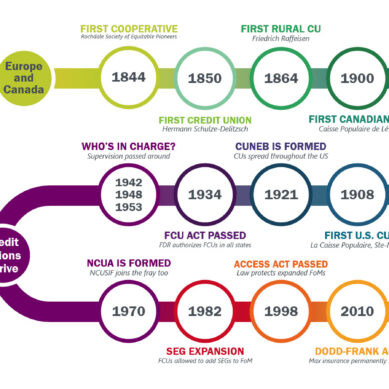This is the first in a series of articles that will address possible strategies and tactics that credit unions can adopt as alternatives to mergers.
Here at Xtend, we recently studied over 200 NCUA merger applications submitted by credit unions between Oct 2021 and Oct 2022. As a result of this analysis, we have identified seven primary reasons credit unions have given as the response to a merger request.
In this series, the objective is to provide alternative strategies and tactics that credit unions can adopt to avoid the finality of a merger. It is also our hope to provide CUSOs with a variety of strategies they can pursue to better support those credit unions considering possible mergers and establish a level of credit union viability that guarantees a healthy and vibrant market for CUSO-based solutions.
Credit unions need to look more “broker-like”
The continuing decline in the number of U.S. credit unions presents challenges for our entire industry. For the over 800 CUSOs in the U.S., it signals a shrinking market for the broad range of products, solutions, and delivery channels now supported by credit union-owned CUSOs. It is a threat to the healthy balance sheets and income statements of CUSOs that now supply market efficiencies and economies of scale for many of the essential financial products needed by credit union families.
Just about all of these merger applications include multiple reasons for the request, but the largest percentage (73%) of those studied list the need to increase product and service offerings as the primary opportunity offered by a merger strategy.
Many of these small- to medium-sized credit unions have come to the conclusion that the modern financial institution menu of products is something they either lack the financial capacity, managerial expertise, or market scale to offer. These credit unions have decided that without this broad range of product and service offerings, they cannot grow or expand their membership and their balance sheets.
Adopting the brokerage business model
In the American financial services market, there are thousands of small businesses that market a plethora of consumer investment and insurance products and services. These businesses operate as “brokers” for those products and services that are created and managed by large “manufacturers.” These manufacturers supply the product expertise and operating platforms necessary to support what are often extremely complex, highly regulated, and capital-intensive product and delivery channels.
Many CUSOs and credit unions already support a “brokered” business model as their mortgage services business model. Mortgages are sold, fee income replaces traditional spread income, and the credit union often retains its brand identity with its member as the product is serviced by the originating credit union through its maturity.
Billions of dollars of credit union member investment and financial planning assets are under the management of brokered partnerships between credit unions and trusted third partners. Once again, fee income is recognized by the credit union as these member balances are moved off-balance sheet. Credit unions of all sizes have a proven record that they can manage the member relationship without taking on the operational difficulties and balance sheet risk of managing the asset or liability. They utilize all of this while retaining the credit union brand identity between member and product.
Can small credit unions adopt a sustainable brokerage model? How can CUSOs support a growing brokerage model among all credit unions?
Credit union strategies and tactics as merger alternatives
- Never accept that you are too small to provide the full range of products and services your members need and want. This is especially true of loan products and services. There are mortgage, auto, student loan, and business services CUSOs who can help you offer a branded solution, no matter the size of your balance sheet. Utilize the broker channel for the full range of loan products. Identify the relationships and partnerships that will make sure that you never have to say NO to a member.
- Adopt the strategy that you will NOT be a balance sheet lender, and that you will earn your income in the form of fees. Recognize that the brokerage model reduces operating overhead and it will also reduce the many costs and risks of managing a balance sheet.
- For those back office operations that you absolutely still must support, identify shared resources together with other credit unions that can also reduce your overhead and reduce your dependency on highly skilled and tight markets for subject matter expertise.
- Recognize that you will accept technology-driven delivery channels as a substitute for the physical brick-and-mortar branches of the past. Identify proven strategic partners and affordable tool sets that support this virtual strategy—they already do exist in our CUSO/credit union network.
- Do what you do best: manage the member relationship. Be the best at identifying partners who will support your goal to be the best at member service and supply you with best-of-breed products, services, and delivery channels at affordable prices.
- If you can’t find a partner to support your brokerage model then talk to your peers, your state league, and associations like NACUSO. This is the very reason why the CUSO model exists. If you can’t find the partners you need then let’s create them. The credit union network holds over $2 trillion in assets today. That means that there are millions of dollars of capital that should be and can be leveraged to support credit unions of all sizes.
- Instead of talking to a bigger credit union about a merger, talk to them about a partnership. Participation lending, shared back office support programs, and shared executive development programs. Offer to be an independent brand that supports and accesses its established deposit, lending, and delivery solutions but retains its own charter and distinct identity.
CUSO strategies and tactics to reduce merger activity
- Identify, publish, and actively pursue special pricing models that will support and yes, subsidize small and medium-sized credit unions that need your solution set. Ask that your credit union owners support the investment necessary to combat current merger trends. Differentiate yourself from your for-profit competitors by adopting pricing models that fit the capacity and financial requirements of all-size credit unions. Too many CUSOs today are starting to look like the for-profit competitors we were created to replace.
- Research and create the specialized capacity to deliver your products and services as a manufacturer in the brokerage business model. Study the insurance and financial advisory business models that have successfully utilized a brokerage business model for many years. Invest in the strategy and tactics necessary to support and succeed in this unique delivery channel.
- Build a collaborative solution set with other CUSOs that can present a united and common package of products, services, and delivery channels customized for the brokerage business model and available to the de novo and small credit union communities.
- Recognize that individual credit union brands and communities are all valuable, regardless of size or even growth potential. Their very cooperative uniqueness is the differentiator between them and the rest of the financial services world. The success of your CUSO depends on the viability of a business model that supports credit unions of all sizes.
Remember, the list of alternatives to a merger is vast. Mergers among credit unions should be a last resort, not the tsunami we have witnessed in the last decade plus.
What’s next?
Join those who are making strides, putting their money where their mouth is, and creating measurable impacts for credit unions. Contact us at info@cusodriven.com for more information.



























































